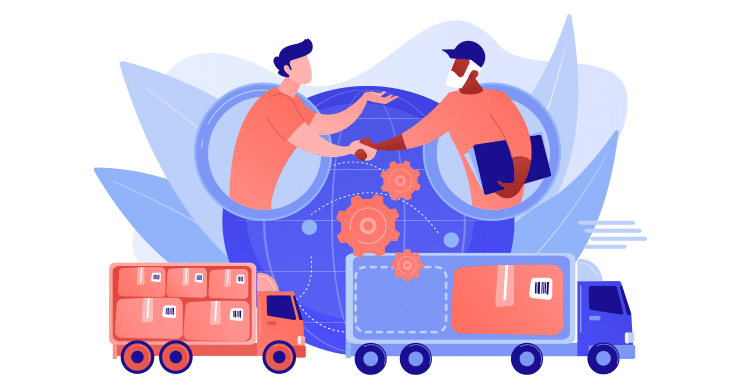What is Vendor Risk Management?
Managing the risks posed by the large network of vendors associated with a company is becoming increasingly complex. If you’re serious about portraying your company as a reputable, responsible entity, it’s essential to have strong governance and oversight of your extended enterprise. This includes visibility and control over your supply chain, vendors, and other material third-party risks.
Across all industries, business success is increasingly reliant on managing the ever-growing network of vendor relationships. Vendors and the risks they pose are not limited to the supply chain. Vendor relationships are being leveraged daily to deliver core capabilities in businesses such as cloud-based applications and outsourced primary services.
When we talk about vendor management risks, we refer to the assessment of vendor risks and the management of associated risks. Ultimately, vendor risk management is focused on building resilience while depending on third-party vendors.

Key Factors Driving the VRM Revolution
- Financial considerations and reliance on vendors
- Regulatory risks
- Customer pressure
- Public interest
- Need for transparency and control in expanding networks
Important Advice for VRM
Success in vendor risk management does not come from simply following a tried-and-true framework. You’ll need to support your system with tools and methods, as well as practical and rigorous implementation strategies. But above all, the key factor in success is taking a proactive approach to vendor risk management.
Many organizations make the mistake of thinking about vendor risk management after a cyber incident or following a major news headline in their industry. Today we will talk about setting up your VRM in a strategic way that enables organizations to identify and address potential risks before they can have a serious impact.
The Benefits of Vendor Risk Management
Vendor risk management tools provide many benefits to organizations. These include:
Reduced risk
Proactively assessing and monitoring risk across all vendors promotes consistency and ensures that every vendor is meeting your business and security requirements, thus significantly reducing exposure to potential risks from vendors.
Improved compliance
A streamlined process to manage vendors ensures that all vendors are being monitored and helps confirm vendors’ compliance with required laws and regulations, while also keeping your organization compliant with regulations that mandate vendor risk management and reducing the risk of heavy fines and penalties.
Enhanced security
Overseeing all providers and understanding their risk posture gives your organization a clear picture of what needs improvement and where. A VRM program keeps track of vendors and ensures that they are constantly improving their security measures, essentially enhancing your organization’s security as well
Increased efficiency
A comprehensive VRM beats outdated spreadsheets by streamlining the processes and giving your company full visibility over your vendors’ security postures, allowing you to quickly identify and address potential problems.
Framework Profiles
Initially, integrating a VRM program will be costly, but after the preliminary overhead, it significantly reduces yearly expenses. This is in addition to the costs associated with no program at all, such as regulatory fines, data breaches, and reputational damages.
Start Getting Value With
Centraleyes for Free
See for yourself how the Centraleyes platform exceeds anything an old GRC
system does and eliminates the need for manual processes and spreadsheets
to give you immediate value and run a full risk assessment in less than 30 days
Vendor Risk Management Best Practices
Continuous Monitoring
Once a vendor is onboarded, it does not mean the organization can ignore them. Every vendor should be under continuous monitoring. Monitoring gives companies the ability to keep tabs on their suppliers. The monitoring process should include frequent reviews of the vendor’s performance, as well as tracking changes in the vendor’s risk profile. A change in profile would indicate that a risk assessment needs to be conducted again to determine if the vendor is still at an appropriate severity level. Organizations should also review the vendor’s security and privacy policies, and other compliance requirements regularly.
Vendor Risk Management Automation
VRM can be time-consuming especially if you want to do it right and feel satisfied that you are effectively managing your vendors. New vendors are being onboarded, new regulations, and a constantly shifting cyber world with new risks being discovered daily. An automated vendor risk management program is where it’s at, allowing you to easily keep track of your vendor risk while keeping your VRM relevant to the changing times. Automation ensures that vendors are onboarded in a smooth, fast, and clean operation. It means easy scanning and tracking, clear risk information on every vendor, and detailed reports. It allows you to step back with the knowledge that your vendors are in good hands.
Streamline Document Exchange and Evidence Collection
Automated evidence collection is your best friend for capturing and tagging data that you need from vendors. Many types of evidence need to be collected for vendor management audit programs as snapshots of a data protection system, complete with timestamps and other relevant metadata. Be aware that you’ll also need a system that triggers alerts if an automated process fails.
Quantity Risk Impact by Creating a Risk Profile
Centraleyes automatically creates a vendor risk profile by quantifying the impact and the probability of an attack on a vendor, using a combination of internal categorization, vendor self-attestation, certifications, and other supporting documents. In parallel, it conducts automated threat intelligence scanning of the vendors’ internet-facing risk surface, which includes unprotected assets, ongoing and previous attacks, and breaches, along with a variety of other key data points.
Using this hybrid vendor risk profiling approach, we create the most accurate vendor risk segmentation for our customers’ third parties, helping them lower their third-party risk exposure with an easy click of a button!
Make Upper Management a Partner in Your Plans
Getting business leadership sponsorship is key to ensuring the effectiveness and long-term adoption of a program. Be ready to make your business case to the executive team. Being able to articulate why vendor risk assurance is critical with compelling data to show the benefits of improved supplier relationships.
Appoint Dedicated Resources
Appoint a dedicated team or resource to take responsibility for ensuring proper vendor risk management. The exact size of such a team depends on the needs of your business, and the amount of vendors you are trying to manage, that said the technology solutions you are using will impact the number quite drastically. Define their responsibilities considering the following:
- Vendor selection: Every new prospective supplier requires due diligence from the team. Choose the contractors and suppliers that are in line with your overall financial and business objectives.
- Transaction screening: Every purchase and contract made through an entity on the supplier list should also go through this vendor management team.
- Relaying communication: The team also acts as a liaison between other vendors and the stakeholders within the company, for example, between Human Resources and suppliers regarding professional services.
- Performance reviews: You need to make sure current vendors match up with your needs while keeping in mind how they will fit into your company in the future. Conducting regular performance reviews is another responsibility of this team.
- Auditing: Meticulous record keeping should be another responsibility of vendor risk management. Having a “paper trail” of documents, invoices, and purchase orders will help you audit your financial activity later down the line.
Know When To Quit
Think of vendors as employees; if one fails to provide the value you expect, then it’s time to assess and reconsider. Regular awareness of how much you are gaining or losing from each vendor is key to digging out problematic contracts.
If you do find it necessary to break up a relationship, develop a formal vendor management policy for off-boarding. Most contracts have terms in place regarding the handling of sensitive information and assets during a termination.
Empower Yourself With Automation
With sourcing and vendor management becoming more complicated by the day, businesses are turning largely to software and other related technologies to address some of the challenges.
The power of automation is a game changer in vendor risk management. Automating your vendor risk program can allow you to reach many more vendors with fewer resources and at the same time improve both the vendors’ cooperation and the accuracy of their responses. On top of this, collecting automated external data sources can help validate many of the self-attested items the vendor provides, all this leading to a much more robust and data-driven vendor risk management program.
The data from B2B purchases can come from a wide variety of sources like emails, documents, digital files, scans, and others. Orchestrating all this disparate data together in consistent format matters when it comes to efficient auditing and recordkeeping.
Vendor risk management solutions specialize in automating the data collection process and turning that data into actionable insights that highlight a vendor’s adherence to basic governance, risk, and compliance while giving the organization the tools to identify the highest-risk vendors at a click of a button. Quantifying what level of impact a vendor has on the organization alongside the likelihood of an attack them is will help you establish a vendor risk score to prioritize those high-risk vendors.
Create a Winning Vendor Risk Management Program With Centraleyes
Effective vendor management policy and best practices are a winning strategy for any company. That’s why it’s more important than ever to ensure your vendors are practicing the same level of risk management.
Centraleyes’s 3rd party solution allows you to automate and orchestrate your vendor risk program. Through the platform, you can easily onboard, assess and visualize vendor risk at scale. Through powerful automation, you can leverage preloaded frameworks, which combine self-attestation by vendors together with automated cutting-edge threat intelligence the Centraleyes platform collects from the Dark Web, Public, and vendor perimeter. With intuitive functionality managing vendor risk has never been easier and more efficient.
Are you interested to see how top companies leverage the Centraleyes platform to measure their vendor risk?
Start Getting Value With
Centraleyes for Free
See for yourself how the Centraleyes platform exceeds anything an old GRC
system does and eliminates the need for manual processes and spreadsheets
to give you immediate value and run a full risk assessment in less than 30 days






